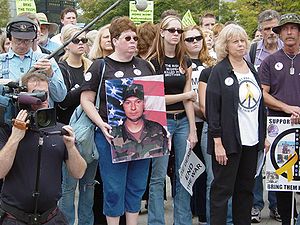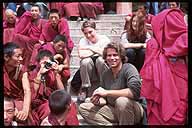I'd love a "Mommies for Peace" in a fun, funky font??????
Based on that "Design your Prize" request I came up with a couple of new graphics this past week. Peace Mommie and Mommies for Peace. These are themselves reworkings of the intermittently popular Peace Mom, which I designed early in 2007.
The fonts are a combination of 'blomster', 'heartland regular' and 'peace' which are themselves a variation on 'floraless'. Most of the design time was spent paint-bucketing the colours into flowers, hearts and peace signs.
I'm tickled by these designs. They're fun and the fonts make for a kiddish, whimsical image that takes the edge off the message without undermining it. And if you don't take mothers seriously, just consider the effectiveness of Cindy Sheehan and the Four Mothers movement.
Cindy Sheehan
| Cindy Sheehan | |
|---|---|
 Cindy Sheehan gives the peace sign in front of the White House in 2006. | |
| Born | July 10, 1957 |
| Occupation | Activist |
| Website | http://www.gsfp.org/ |
Cindy Lee Miller Sheehan (born July 10, 1957) is an American anti-war activist, whose son, Casey Sheehan, was killed during his service in the Iraq War on April 4, 2004, aged 24. She attracted international attention in August 2005 for her extended demonstration at a peace camp outside President George W. Bush's Texas ranch garnering her both support and criticism. In May 2007, Sheehan officially ended her involvement as an anti-war activist, saying "I am going to go home and be a mother to my surviving children and try to regain some of what I have lost."[1] On July 8, 2007, in the wake of President Bush's reduction of the sentence of Scooter Libby, Sheehan announced that she plans to challenge Speaker Nancy Pelosi should Pelosi fail to introduce articles of impeachment against President Bush.
Anti-war campaign
Sheehan states she initially questioned the urgency of the invasion of Iraq, but did not become active in the anti-war effort until after her son's death.[2]
Sheehan and other military families met with President George W. Bush in June 2004 at Fort Lewis, near Tacoma, Washington, nearly three months after her son's death. In a June 24, 2004 interview with the Vacaville Reporter published soon after the meeting, she stated, "We haven't been happy with the way the war has been handled. The President has changed his reasons for being over there every time a reason is proven false or an objective reached." She also stated that President Bush was "... sincere about wanting freedom for the Iraqis… I know he's sorry and feels some pain for our loss. And I know he's a man of faith."[3]
Sheehan gave another interview on October 4, 2004, stating that she did not understand the reasons for the Iraq invasion and never thought that Iraq posed an imminent threat to the United States. She further stated that her son's death had compelled her to speak out against the war. [2]
During the Presidential Inauguration in January 2005, Sheehan traveled to Washington, D.C. to speak at the opening of "Eyes Wide Open: the Human Cost of War", a traveling exhibition created by the American Friends Service Committee that displays pairs of combat boots to represent every U.S. military casualty. There she met others who lost family members in Iraq, and together they planned to create an organization for similar families. Sheehan wrote about the experience in a commentary article.[4] She was also a featured speaker when the exhibition opened in San Diego in March 2005[5] and traveled with the exhibition to other locations. "Behind these boots is one broken-hearted family," she stated as she donated her son Casey's boots to travel with Eyes Wide Open when it stopped in San Francisco later that month.[6]
Sheehan is one of the nine founding members of Gold Star Families for Peace, an organization created in January 2005 that seeks to end the U.S. presence in Iraq and provide support for families of fallen soldiers. As of August 2005, at least 63 other relatives of fallen soldiers are listed as members.
Although she had spoken publicly against the Iraq war and occupation since 2004, and even pledged not to pay her 2004 taxes,[7] Sheehan attracted international attention only in early August 2005. At that time, she traveled to Bush's Prairie Chapel Ranch just outside Crawford, Texas. Demanding a second meeting with the President and an explanation of the cause for which her son died[8][9], she created a peace camp called Camp Casey by pitching a tent by the side of the road and announced her intention to stay for the full five weeks or until such a meeting was granted. She also promised that, were she not granted a second meeting, she would return to Crawford each time Bush visits there in the future.[10] Several cabinet members went out to talk to Sheehan, but she refused stating that she would only talk to the President himself. Toward the end of her vigil, she said she was "very, very, very grateful" Bush did not grant her that meeting because it would have ended the momentum the peace movement gained from the popularity of her demonstrations.[11]
Sheehan's actions have led supporters such as Rev. Lennox Yearwood, CEO of the Hip Hop Caucus, to describe her as "the Rosa Parks of the antiwar movement."[12] Later during the demonstration, Sheehan also gained the label of "Peace Mom" from the mainstream media.[13][14][15][16]
Some of her statements have caused controversy.[citation needed] One such comment she wrote on her Daily Kos diary on September 24, 2005, accusing the media of excessive media coverage of Hurricane Rita:
| “ | [I] am watching [CNN] and it is 100 percent [R]ita... even though it is a little wind and a little rain... it is bad, but there are other things going on in this country today... and in the world!!!![17] | ” |
In March 2005, James Morris sent an e-mail to ABC's Nightline allegedly written by Sheehan that included the statements that Casey Sheehan "was killed for lies and for a PNAC Neo-Con agenda to benefit Israel" and that he had "joined the Army to protect America, not Israel." Sheehan denies the allegations: "I've never said that... Those aren't even words that I would say. I do believe that the Palestinian issue[18] is a hot issue that needs to be solved, and it needs to be more fair and equitable, but I never said my son died for Israel." She claims that Morris modified the email to support his own personal agenda. Morris denies altering the email before sending it along to Nightline[19] on Sheehan's behalf (per her request for him to do so). Two other individuals, Tony Tersch and Skeeter Gallagher, received a copy of Sheehan's email directly from her; both claim that the e-mail they received is consistent with Morris' story, rather than Sheehan's. Tersch posted the email[20] he received to the "bullyard" Google group.
Cindy Sheehan on May 12, 2006 published a letter titled "Oh no, Canada".[21] In the letter, she wrote that the Canadian Prime Minister Stephen Harper was "wildly unpopular from coast to coast up north and there is a growing sense of unease about his emulation of a very unpopular person in the USA but even more in Canada: George Bush." However, in March, SES Research released the results of a poll[22] indicating that more Canadians in every part of the country chose Harper as the one who would make the best Prime Minister from among the five major party leaders.
She has plans to build a therapy center across from President Bush's ranch for returning war victims.It uses material from the Wikipedia article Cindy Sheehan
Featured Items














